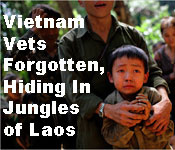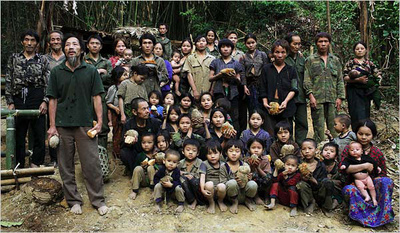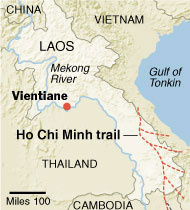 Old U.S. Allies, Still Hiding Deep in Laos
Old U.S. Allies, Still Hiding Deep in Laos
by Thomas Fuller, New York Times
Left, A recent visit to Yang’s jungle hideout was the first to any camp of Secret War veterans by an American newspaper reporter. Family members broke down in tears and begged for help from the visitors.
VIENTIANE PROVINCE, Laos — They call themselves America’s forgotten soldiers.
Four decades after the Central Intelligence Agency hired thousands of jungle warriors to fight Communists on the western fringes of the Vietnam War, men who say they are veterans of that covert operation are isolated, hungry and periodically hunted by a Laotian Communist government still mistrustful of the men who sided with America.
“If I surrender, I will be punished,” said Xang Yang, a wiry 58-year-old still capable of crawling nimbly through thick bamboo underbrush. “They will never forgive me. I cannot live outside the jungle because I am a former American soldier.” (continued…)
In a small hillside clearing about nine miles east of the Mekong River, Mr. Yang and four other veterans scratch out a primitive existence with their wives and 50 children and grandchildren. Their hidden jungle encampment is a 15-hour walk up and down low-lying mountains from the nearest paved road, across streams that are knee-deep in the dry season but can become roaring torrents when the monsoon comes.
Mr. Yang said his group had been attacked by the Laotian Army twice this year. In September, soldiers killed a 5-year-old boy, whose grave is on the outskirts of the camp. In May, a predawn raid killed a woman and her 2-year-old child. The group moves camp every few weeks to avoid attack, he said.
They are often miles from any rice paddies or hamlets, but sometimes they travel at night, with their AK-47s, to get supplies from sympathetic farmers. They say they got their guns and uniforms from Laotian troops who fled a firefight in 1999.
The C.I.A. operation, from 1961 until 1975, became known as the secret war because, unlike in Vietnam, America’s military involvement in Laos was covert. Instead of sending American ground troops to prevent a Communist takeover here, the C.I.A. hired tens of thousands of mercenaries, most of whom were Hmong, a hill-dwelling ethnic minority.
Today, the number of Hmong veterans and their families who remain hidden in the jungle is somewhere in the hundreds to low thousands, estimates Amy Archibald, a spokeswoman for the United States Embassy in Vientiane, the capital.
Their plight, though little known, has received more attention in recent years, as human rights groups have issued reports condemning the Laotian government for attacking Hmong who worked with the Americans.
Still, finding the veterans in their camps is an arduous undertaking, requiring hours of trekking through the jungle. A recent visit to Mr. Yang’s remote hide-out by this reporter was the first by an American newspaper, one of about a dozen people to have visited any camp of veterans of the C.I.A. operation in Laos.
The former fighters and their progeny clearly welcomed the visit. When this reporter and a photographer arrived at the camp, many of the group began weeping and saying, in Laotian, “America help us, America help us.”
Many in the group said they had not seen a Westerner since the war ended in 1975.
Each of the five veterans in the camp has relatives in the United States; they say their fading dream is to be reunited with them. Mr. Yang’s hope is that Washington will “come back to help old soldiers like me to leave Laos and make it to America.”
“We want America to give us a place to live,” said another veteran, Va Chang, 60. “We want America to give us food and medicine.
“If the Americans don’t want to do that,” he said, “they should drop a big bomb on us and end our misery.”
Reports of Attacks
Human rights groups describe a mostly one-sided fight between the lightly armed and ragged former C.I.A. fighters and a Laotian Army eager to dislodge them from their jungle hide-outs.
An Amnesty International report released in March said that Laotian troops had been involved in numerous attacks on the veterans and their families across northern Laos in recent years, an assessment shared by American diplomats.
“We find these reports very credible, and we know that there are human rights abuses by security forces,” Ms. Archibald said. “What we can’t tell you is who fired the first bullet.”
The State Department’s annual human rights report, released in March, cited increased efforts by security forces to eliminate scattered pockets of Hmong fighters. Pressure by the Laotian Army, the report said, “was intended to starve the remnants of insurgent families from their jungle dwellings.”
The Laotian government, perhaps wary of the effect the conflict might have on the country’s thriving tourism industry, denies that any clashes have occurred or that any C.I.A. veterans are still in hiding.
“There are no Hmong C.I.A. in the jungles,” said Yong Chanthalangsy, a Foreign Ministry spokesman. “There are no clashes. As you may notice by traveling in our country, there is a peaceful atmosphere.”
He said Mr. Yang and his group were probably just “bandits.”
On the run for the past three decades, the five men have no documents proving they fought in the war. But they can cite the code names of C.I.A. landing strips they guarded and some of the Americans they served with, including a “Mr. Tony,” possibly Tony Poe, the onetime leader of the C.I.A.’s operations here who died in 2003.
Shrapnel is still visibly embedded in some of their bodies, and one veteran, Jangwang Xiong, 57, has a damaged leg, from a clash in 1971 with forces backed by North Vietnam, he said.
 Missions for the C.I.A.
Missions for the C.I.A.
The C.I.A. initially hired the Hmong to back the Laotian government in its fight against a Communist insurgency. Later, during the course of the Vietnam War, the Hmong were instructed to intercept convoys of supplies on the series of jungle paths known as the Ho Chi Minh trail, much of which ran through Laos.
Mr. Chang said he was ordered to defend Lima Site 258, one of dozens of mountaintop landing strips that the C.I.A. used to hopscotch around the country with supplies and men.
The group is indigent even by the standards of rural Indochina. Its members’ diet consists mainly of wild yams collected from the jungle, bamboo shoots and small animals hunted with bows and arrows. Occasionally they obtain rice from villagers willing to risk secretive association with them.
Surrounded by their worn-looking children and grandchildren, the five men appear older than their years and today bear little resemblance to the young Hmong tribesmen who collectively earned a reputation as capable fighters.
Colin Thompson, a C.I.A. officer in Laos from 1963 to 1966, remembers the Hmong recruits as rugged and loyal.
“There were some extraordinarily brave Hmong,” he said in a telephone interview from his home in Maryland. “They were a little tougher to beat back than were the other tribal groups. They stood their ground.”
Mr. Thompson’s job included carrying stacks of Laotian currency for the Hmong soldiers’ salaries. He is sympathetic to the plight of the remaining fighters but said Washington need not feel obligated to bring them to America.
“It wasn’t as if we dragooned them into anything,” he said. “Their choice was to defend themselves and we provided the means. We provided the weapons and the courage.”
That view is not shared by the Hmong, many of whom felt betrayed by the United States when the war ended. Using battered radios, the veterans here have followed what to them are the confusing events of recent years: the friendship proclaimed between Vietnam and the United States and the arrest in June of Vang Pao, the former Hmong general who faces charges in the United States of plotting to attack the Laotian government.
Mr. Pao’s indictment in California, after a federal sting operation in which a government agent posing as an arms dealer offered him weapons, is bewildering to the veterans here. Attacking Communists was the very job Mr. Pao was paid to do by the C.I.A.
Mr. Yang and his group say they still hope for a democratic Laos but have given up any notion that they can assist in the overthrow of the Communist government.
Mr. Yang said he occasionally spoke with one of his daughters, Mao, a postal clerk in California, who moved to the United States 27 years ago after a year in a refugee camp in Thailand.
“I love my father,” Mao Yang said in a phone interview from her home in Yuba City in the Sacramento Valley. “He is hungry and he says he has no clothes.”
She said she that recently sent him $1,200 through intermediaries but that he received only $600.
About 250,000 Laotian refugees moved to the United States in the decades after the 1975 Communist takeover, including more than 115,000 Hmong. Many Hmong stayed in Laos after the war, living normal lives in cities or as farmers. And others, including some members of the group visited here, had the opportunity to seek refugee status in Thailand in the years after the war but chose to remain in the jungle. With the newfound friendship between Thailand and Laos, that window has now closed.
 Thousands on the Run
Thousands on the Run
Boon Thang Van, a veteran of the C.I.A. operation who is an adviser to a United States-based Hmong activist group, the Fact Finding Commission, says 5,060 people — veterans and their families — are still in the jungles, most of them in northern Laos.
The group keeps track of them through 12 satellite phones it has distributed. It has compiled a list of clashes with government troops and has video showing the bodies of five Hmong children after what it says was an attack by government troops in May 2004.
Many Hmong have left the jungles in recent years and fled to Thailand, including 7,800 refugees now in a camp in Phetchabun Province. Of those, 181 have battlefield-type injuries, according to Doctors Without Borders, the international aid group.
“It’s clear that the wounds are recent and caused by guns,” said Gilles Isard, chief of the group’s mission in Thailand. Mr. Isard said many of the people in the camp who claimed to be former C.I.A. fighters had photographs of themselves as young soldiers and documents from the 1960s and 1970s that they say confirm their service.
But their renowned fighting spirit has all but disappeared. Nou Chue Xiong, 68, another of the veterans here, seemed resigned to die in the jungle.
“I guess you will leave here and try to help us,” Mr. Xiong told his visitor. “But if you can’t, don’t be sad.”
Go to original article
"Go to Original" links are provided as a convenience to our readers and allow for verification of authenticity. However, as originating pages are often updated by their originating host sites, the versions posted on VT may not match the versions our readers view when clicking the "Go to Original" links.
(In accordance with Title 17 U.S.C. Section 107, this material is distributed without profit to those who have expressed a prior interest in receiving the included information for research and educational purposes. VT has no affiliation whatsoever with the originator of this article nor is VT endorsed or sponsored by the originator. Any opinions expressed by the author(s) are not necessarily those of VT or representative of any staff member at VT.)
ATTENTION READERS
We See The World From All Sides and Want YOU To Be Fully InformedIn fact, intentional disinformation is a disgraceful scourge in media today. So to assuage any possible errant incorrect information posted herein, we strongly encourage you to seek corroboration from other non-VT sources before forming an educated opinion.
About VT - Policies & Disclosures - Comment Policy




